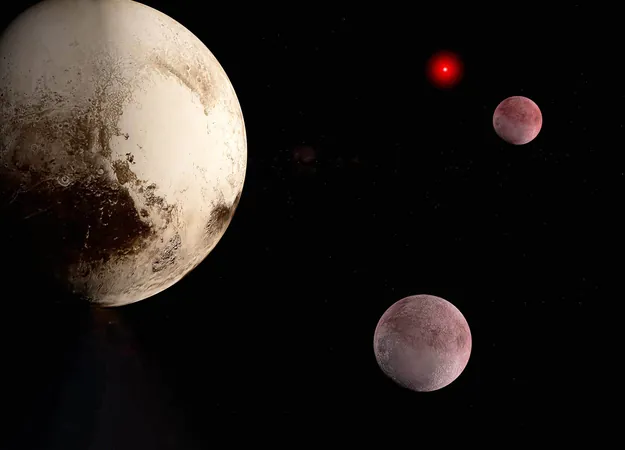
Revolutionary Discoveries: Webb Telescope Unveils Secrets of Icy Planetesimals in Our Solar System
2024-12-29
Author: Yu
Groundbreaking Research from UCF
Groundbreaking research from the University of Central Florida (UCF) has shed light on the icy bodies known as trans-Neptunian objects (TNOs) and centaurs—celestial relics that provide a glimpse into the solar system's cosmic past. Using the James Webb Space Telescope (JWST), scientists have obtained the clearest view yet of these ancient planetesimals, revealing significant insights into their composition and evolution.
Understanding TNOs: Nature’s Time Capsules
TNOs are small, icy bodies orbiting the Sun beyond Neptune, residing in regions like the Kuiper Belt and the even more distant Oort Cloud. These objects vary widely in size and include well-known entities such as Pluto and Eris, as well as other less recognizable entities characterized by their reddish or dark surfaces, formed by complex compounds called tholins.
TNOs are likened to time capsules, preserving key information about the conditions of the early solar system. Their slow and stable orbits have largely shielded them from catastrophic collisions, making them vital to understanding the solar system's formation story.
Diving Deep into Compositions
The innovative investigations by the UCF team have identified three distinct groups of TNOs, categorized based on their ice retention properties dating back to the solar system’s infancy. This revelation is critical; it links the unique chemical makeup of these objects with their formation conditions, providing a comprehensive view of how celestial bodies came into existence billions of years ago.
The temperature gradients in the early protoplanetary disk influenced where different types of ices could form and persist, effectively sculpting the diverse landscape of the outer solar system.
Centaurs: A Bridge between Two Worlds
In addition to TNOs, the research also explored centaurs—TNOs that have migrated into the inner solar system after gravitational interactions with Neptune. As these objects warm, they can transition to exhibit comet-like characteristics, including the development of tails. This transformation highlights the dynamic nature of celestial bodies and their journeys through different regions of the solar system.
The study unveiled unique spectral signatures from centaurs, revealing their dusty surfaces that distinctively differ from those of TNOs. This suggests that their extensive travels across the solar system have instigated notable changes in their characteristics and compositions.
Unlocking the Mysteries of the Outer Solar System
The research represents a significant advance in our understanding of the outer solar system, hinting at the complex processes that shaped it—the same processes that resulted in the majestic gas giants and their moons. Scientists are now better equipped to explore how these compositional groups formed and interacted, deepening our grasp of planetary formation theories.
The findings not only enhance our knowledge about TNOs and centaurs but open new avenues for future research. With JWST's advanced capabilities, astronomers are optimistic about making even more exciting discoveries about our solar system's origins and evolution.
Looking Ahead
With ongoing studies set to focus on the nuances of the identified compositional groups, the future holds the promise of even more exhilarating revelations. The exploration of TNOs and centaurs may soon unlock further secrets about the formation of our solar system and perhaps even the potential for finding life-supporting materials within these distant, frozen worlds.
The full study, published in Nature Astronomy, is a testament to the transformative power of advanced telescope technology and the collective efforts of researchers dedicated to unraveling the mysteries of the cosmos.
 Brasil (PT)
Brasil (PT)
 Canada (EN)
Canada (EN)
 Chile (ES)
Chile (ES)
 Česko (CS)
Česko (CS)
 대한민국 (KO)
대한민국 (KO)
 España (ES)
España (ES)
 France (FR)
France (FR)
 Hong Kong (EN)
Hong Kong (EN)
 Italia (IT)
Italia (IT)
 日本 (JA)
日本 (JA)
 Magyarország (HU)
Magyarország (HU)
 Norge (NO)
Norge (NO)
 Polska (PL)
Polska (PL)
 Schweiz (DE)
Schweiz (DE)
 Singapore (EN)
Singapore (EN)
 Sverige (SV)
Sverige (SV)
 Suomi (FI)
Suomi (FI)
 Türkiye (TR)
Türkiye (TR)
 الإمارات العربية المتحدة (AR)
الإمارات العربية المتحدة (AR)